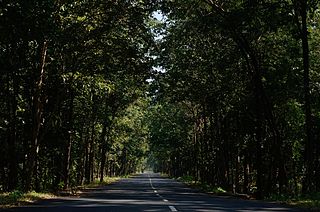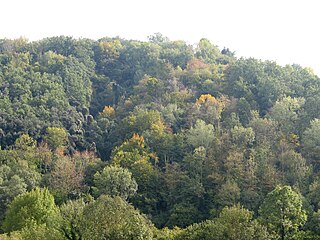
A tree inventory is the gathering of accurate information on the health and diversity of a community forest. [1]

A tree inventory is the gathering of accurate information on the health and diversity of a community forest. [1]
Tree inventories focus on the attributes of individual trees, as compared to a forest inventory which seek to assess timber attributes on forest stands.
Information such as how many street trees there are, what their species is, and their condition is gathered. A community forest cannot be effectively managed unless its condition is known. A tree inventory may be conducted for many reasons, such as to determine if a community needs to implement an urban forestry program, in order to prioritize tree maintenance needs, to plan for the community's future, and to provide a basis for the implementation of a management plan. A tree inventory should provide tree species, preferably in binomial nomenclature (Latin names), size, such as DBH (diameter at breast height) and tree height, crown width, overall condition such as health and maintenance needs, overcrowding, possible problems, presence or absence of insects or diseases. Characteristics of the site should also be listed such as soil type and condition, root space, and safety.
There are four main types of tree inventory. [2] They are specific problem inventory, partial inventory, complete inventory, and cover type inventory. A specific problem inventory gathers data on one particular problem such as looking at the effects of Hemlock Woolly Adelgid or Dutch elm disease. A partial inventory uses sampling where only a subset of the trees in the community are observed to draw inferences on the whole forest. A complete inventory collects data from all trees in the population, and a cover type survey is a survey where some of the information gathered is usually done through aerial photography and GIS systems. This type of survey is being increasingly used in urban areas. [3] These inventories are generally conducted by student groups and volunteers, or contracted to urban forestry consultants, or by municipal urban foresters using either handwritten methods, software, templates, or PDAs.

Forestry is the science and craft of creating, managing, planting, using, conserving and repairing forests, woodlands, and associated resources for human and environmental benefits. Forestry is practiced in plantations and natural stands. The science of forestry has elements that belong to the biological, physical, social, political and managerial sciences. Forest management play essential role of creation and modification of habitats and affect ecosystem services provisioning.

Urban forestry is the care and management of single trees and tree populations in urban settings for the purpose of improving the urban environment. Urban forestry involves both planning and management, including the programming of care and maintenance operations of the urban forest. Urban forestry advocates the role of trees as a critical part of the urban infrastructure. Urban foresters plant and maintain trees, support appropriate tree and forest preservation, conduct research and promote the many benefits trees provide. Urban forestry is practiced by municipal and commercial arborists, municipal and utility foresters, environmental policymakers, city planners, consultants, educators, researchers and community activists.

The Center for International Forestry Research (CIFOR) is a non-profit scientific research organization that conducts research on the use and management of forests with a focus on tropical forests in developing countries. CIFOR, which merged with World Agroforestry on Jan. 1, 2019, is the forestry and agroforestry research center of the Consultative Group on International Agricultural Research (CGIAR), a network of 15 research centers around the world that focus on agricultural research for sustainable development, working closely with governments and other partners to help develop evidence-based solutions to problems related to sustainable agriculture and natural resource management.

Toronto Parks, Forestry & Recreation (PFR) is the division of Toronto's municipal government responsible for maintaining the municipal park system and natural spaces, regulation of and provision of urban forestry services, and the delivery of recreational programming in city-operated facilities.
An urban forest is a forest, or a collection of trees, that grow within a city, town or a suburb. In a wider sense, it may include any kind of woody plant vegetation growing in and around human settlements. As opposed to a forest park, whose ecosystems are also inherited from wilderness leftovers, urban forests often lack amenities like public bathrooms, paved paths, or sometimes clear borders which are distinct features of parks. Care and management of urban forests is called urban forestry. Urban forests can be privately and publicly owned. Some municipal forests may be located outside of the town or city to which they belong.
The following outline is provided as an overview of and guide to forestry:

Social forestry is the management and protection of forests and afforestation of barren and deforested lands with the purpose of helping environmental, social and rural development. The term social forestry was first used in 1976 by The National Commission on Agriculture, when the government of India aimed to reduce pressure on forests by planting trees on all unused and fallow lands. It was intended as a democratic approach to forest conservation and usage, maximizing land utilization for multiple purposes.
A needs assessment is a systematic process for determining and addressing needs, or "gaps" between current conditions and desired conditions or "wants". The discrepancy between the current condition and wanted condition must be measured to appropriately identify the need. The need can be a desire to improve current performance or to correct a deficiency.
Forest farming is the cultivation of high-value specialty crops under a forest canopy that is intentionally modified or maintained to provide shade levels and habitat that favor growth and enhance production levels. Forest farming encompasses a range of cultivated systems from introducing plants into the understory of a timber stand to modifying forest stands to enhance the marketability and sustainable production of existing plants.
Private landowner assistance program (PLAP) is a class of government assistance program available throughout the U.S. for landowners interested in maintaining, developing, improving and protecting wildlife on their property. Each state provides various programs that assist landowners in agriculture, forestry and conserving wildlife habitat. This helps landowners in the practice of good land stewardship and provides multiple benefits to the environment. Some states offer technical assistance which includes:
Forest inventory is the systematic collection of data and forest information for assessment or analysis. An estimate of the value and possible uses of timber is an important part of the broader information required to sustain ecosystems. When taking forest inventory the following are important things to measure and note: species, diameter at breast height (DBH), height, site quality, age, and defects. From the data collected one can calculate the number of trees per acre, the basal area, the volume of trees in an area, and the value of the timber. Inventories can be done for other reasons than just calculating the value. A forest can be cruised to visually assess timber and determine potential fire hazards and the risk of fire. The results of this type of inventory can be used in preventive actions and also awareness. Wildlife surveys can be undertaken in conjunction with timber inventory to determine the number and type of wildlife within a forest. The aim of the statistical forest inventory is to provide comprehensive information about the state and dynamics of forests for strategic and management planning. Merely looking at the forest for assessment is called taxation.
Casey Trees is a non-profit organization established in 2001 to restore, enhance, and protect the tree canopy of Washington, D.C. The organization plants trees, engages volunteers in tree planting and care, offers an education program open to the public, monitors the District's tree canopy, and advocates and plans for the urban forest.

Monterey County reforestation refers to efforts in Monterey County, California to protect the county's pine forests and urban environment. The native Monterey Pine ecosystem is one of the rarest forest ecosystems in the world. Only a few thousand acres of the endemic trees exist in four locations along the Pacific Ocean on the Central Coast of California. The Monterey Peninsula is home to the largest of these stands, but these trees are threatened by development, non-native invasive species, and diseases. The city of Monterey itself maintains more than 19,000 trees in parks and along streets, and about 300 acres (1.2 km2) of Monterey Pine forest.

Community forestry is an evolving branch of forestry whereby the local community plays a significant role in forest management and land use decision making by themselves in the facilitating support of government as well as change agents. It involves the participation and collaboration of various stakeholders including community, government and non-governmental organisations (NGOs). The level of involvement of each of these groups is dependent on the specific community forest project, the management system in use and the region. It gained prominence in the mid-1970s and examples of community forestry can now be seen in many countries including Nepal, Indonesia, Korea, Brazil, India and North America.

The Nebraska Forest Service is the state forestry agency for the state of Nebraska. The Nebraska Forest Service serves the citizens on Nebraska by operating with the mission to provide services and education to the people of Nebraska for the protection, utilization and enhancement of the State's tree, forest and other natural resources. Headquartered in Lincoln, Nebraska, the Nebraska Forest Service is embedded within the Institution of Agriculture and Natural Resources at the University of Nebraska-Lincoln.

Close to nature forestry is a management approach treating forest as an ecological system performing multiple functions. Close to nature silviculture tries to achieve the management objectives with minimum necessary human intervention aimed at accelerating the processes that nature would do by itself more slowly. It works with natural populations of trees, ongoing processes and existing structures using cognitive approach, as in the case of uneven-aged forest (Plenterwald). Its theory and practice takes forest as a self regulating ecosystem and manages it as such.

The deforestation in British Columbia has occurred at a heavy rate during periods of the past, but with new sustainable efforts and programs the rate of deforestation is decreasing in the province. In British Columbia, forests cover over 55 million hectares, which is 57.9% of British Columbia's 95 million hectares of land. The forests are mainly composed of coniferous trees, such as pines, spruces and firs.
i-Tree is a collection of urban and rural forestry analysis and benefits assessment tools. It was designed and developed by the United States Forest Service to quantify and value ecosystem services provided by trees including pollution removal, carbon sequestration, avoided carbon emissions, avoided stormwater runoff, and more. i-Tree provides baseline data so that the growth of trees can be followed over time, and is used for planning purposes. Different tools within the i-Tree Suite use different types of inputs and provide different kinds of reports; some tools use a 'bottom up' approach based on tree inventories on the ground, while other tools use a 'top down' approach based on remote sensing data. i-Tree is peer-reviewed and has a process of ongoing collaboration to improve it.

A community orchard is a collection of fruit trees shared by communities and growing in publicly accessible areas such as public greenspaces, parks, schools, churchyards, allotments or, in the US, abandoned lots. Such orchards are a shared resource and not managed for personal or business profit. Income may be generated to sustain the orchard as a charity, community interest company, or other non-profit structure. What they have in common is that they are cared for by a community of people.
University of Connecticut College of Agriculture, Health, and Natural Resources (CAHNR) is the oldest of UConn's fourteen colleges and teaches a wide range of subjects. The college was originally established for the purpose of conducting research and teaching practical skills to modernize farming. The college faculty conduct research, teach and work with Connecticut communities on subjects like food systems, plant and animal agriculture, human health, nutrition, and physical activity, and environmental sciences. The college describes its mission as working "toward a global sustainable future."